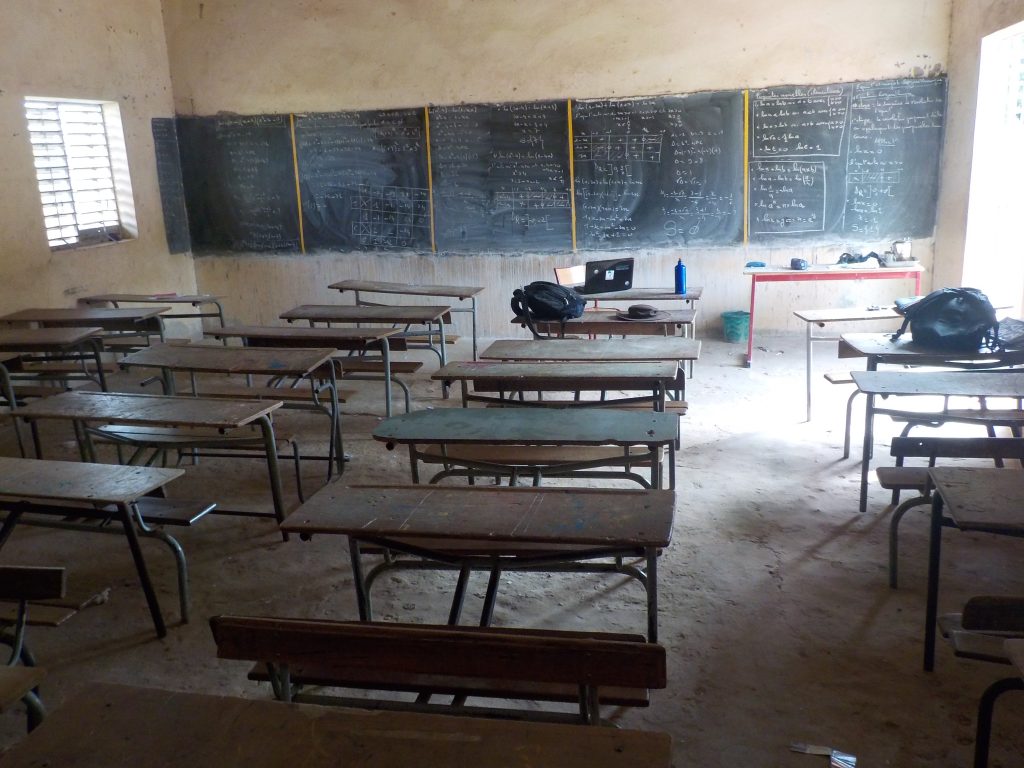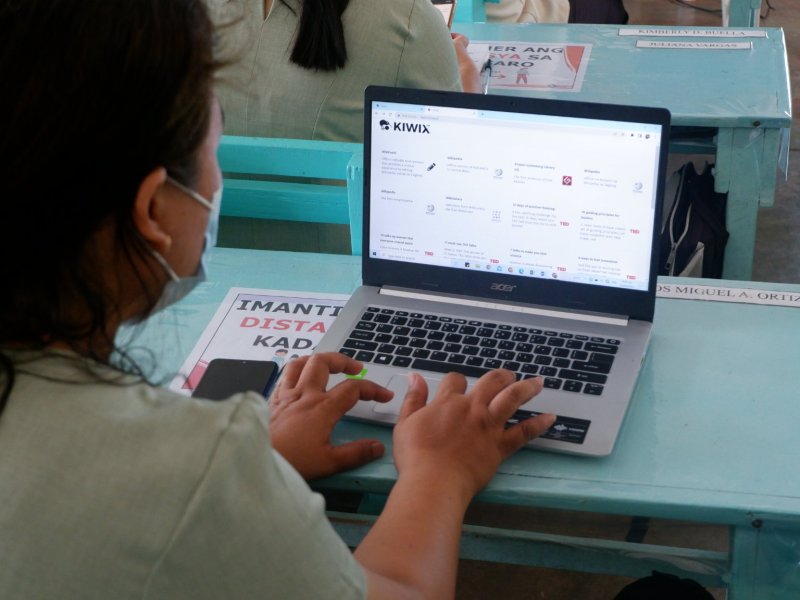Senior Program Manager Anne Gomez leads the New Readers initiative, where she works on ways to better understand barriers that prevent people around the world from accessing information online. One of her areas of interest is offline access, as she works with the New Readers team to improve the way people who have limited or infrequent access to the Internet can access free and open knowledge.
Over the coming months, Anne will be interviewing people who work to remove access barriers for people across the world. In her first conversation for the Wikimedia Blog, Anne chatted with Emmanuel Engelhart (aka “Kelson”), a developer who works on Kiwix, an open source software which allows users to download web content for offline reading. In this installment, she interviews Gabriel Thullen, a Geneva (Switzerland) Wikimedian, previous Wikimedia CH board member, and school teacher who has worked with schools across West Africa to test the Kiwix offline Wikipedia browser during the 2016–2017 school year. As Gabriel writes in the Wikimedia Education newsletter, “These schools are in cities with limited access to the Internet and in small towns with little or no electricity, no cell phone coverage, and no Internet.”
Both Anne and Gabriel recently participated in the OFF.NETWORK Content Hackathon to advance Kiwix and its distribution of offline Wikipedia. Their conversation is below. You can also read the other parts of this ongoing series.
Anne Gomez: Tell me about what started your interest and involvement with offline Wikipedia? When was it?
Thullen: I consider that there were two phases in my involvement with offline Wikipedia. I was fascinated by the presentations at Wikimania 2012, about Kiwix and Wikipedia Zero. I really got into using Kiwix while helping distribute it at the WMCH booth during the 2013 Wikimania in Hong Kong, and was able to successfully secure a mandate from my employers for the 2014-2015 school year to investigate the pedagogical opportunities opened up by the use of offline Wikipedia and Kiwix. Unfortunately, we waited over a year for the Kiwix plug computers to be produced so that by the time the hardware was delivered to Geneva, the funds had dried up and the school year was over.
The second phase of my involvement started with a trip to Senegal in Summer 2014. As coach of a team of Senegalese wheelchair basketball players playing in different European championships, I was involved in organizing a tournament in Dakar. At the same time, I was checking up on the distribution of a few hundred math books I had shipped to Senegal, and I met with a few teachers and government officials. Having surmised the usefulness of offline Wikipedia for schools with little or no Internet access, I had brought a few dozen USB keys pre-loaded with Kiwix and the French Wikipedia. In all, a few weeks were spent meeting with schools and other facilities like the US Peace Corps training base in Thiès and the Naval Academy in Dakar. They were all quite enthusiastic and receptive when I shared Kiwix with them.
Gomez: What’s been the biggest surprise for you over the years?
Thullen: That must be the detrimental effect of smartphones on what I consider to be basic computer literacy such as knowing how to use a keyboard and mouse, knowing the difference between input and output, between local and remote storage. I have been teaching computer science since the mid-eighties, before the web was developed at CERN here in Geneva. Over the years, the students knew more and more about about computers before coming to school, but I have noticed a sharp reversal in this trend over the past two years as an increasing number of students no longer have a computer at home, all is done with mobile devices and a smart TV.
Gomez: Smartphones have transformed the way people can access the internet. How has this changed the landscape and the way you view offline access?
Thullen: My experience with offline access is limited to Africa. I have a research project which is currently stuck in Limbo due to the rules and regulations of my employer which absolutely forbid the use of smartphones in class by middle school students. I now feel that we need a two-pronged approach to providing offline access for smartphones. Users should be able to install resources directly on their device, or else they should be able to easily connect to a mobile WiFi hotspot which provides these resources.
Gomez: How do you see these devices impacting the future of educational resources?
Thullen: Making educational resources available to smartphones and similar devices only makes sense if the educators are ready and willing to make use of them, and that means that those who develop them need to work closely with the educational community. I see a huge potential for offline resources where I work, in Swiss schools. Switzerland is one of the most connected countries in the World, but in a learning environment you sometimes need access to certain resources but not to the Internet or to any other form of electronic communication – think of exams, for example. I am really excited to be part of what could turn out to be a paradigm shift in the way of teaching and evaluating students.
Gomez: You’ve brought Kiwix on a wifi hub (Raspberry Pi) and thumb drives to pass out to teachers in Senegal. Help me understand the context you’re working in… what makes one better than the other?
Thullen: The Raspberry Pi Kiwix hotspot I built turned out to have a few limitations: it needs a very regular power supply, which means that it is not available 24 hours a day, every day. On the other hand, a USB key is always available and needs no power source. One other factor that needs to be considered is that when users connect to the WiFi, they lose any Internet connexion they may have had. As many people in West Africa communicate by Facebook Messenger, this effectively isolates them from their friends and families. They might be willing to do this for a few minutes, but it might not be a long term solution.
The Raspberry Pi WiFi hotspot and the USB flash drives do not address the same needs. A WiFi hotspot can be used by a group in the same physical location whereas the USB sticks can be used individually and at any time.
Gomez: You and I have talked about the challenges of getting teachers to use and share Wikipedia offline, especially with technical challenges. Thumb drives can easily be wiped and repurposed for storing and sharing other types of content. How are you working with teachers to demonstrate the value of Wikipedia and Kiwix?
Thullen: Music takes up a lot of space. Videos take up even more space. Text takes up very little space. My colleagues have to understand just how much information can be stored on a USB thumb drive if you leave out the videos or the HD photos. It is not obvious to them, and it takes time and practice using the Kiwix program before users are convinced that the whole Wikipedia encyclopedia on that little drive, that “it is really all there” to quote a colleague. What I found out during my trips to Senegal is that a lot of teachers there do not know about Wikipedia, so the first step is to ensure that they are familiar with the encyclopedia, and that no matter how much they know about a subject, they can always find more information. That demonstrates the inherent value of the offline encyclopedia so that they are less likely to delete it and reuse the key for other purposes.
Gomez: What’s the hardest part of the technology to deal with?
Thullen: I have now hit a technological wall in West Africa. Please bear with me as I explain, as this probably applies to most other countries to one degree or another.
When I last went to Senegal, over 60% of the computers I saw were running Windows XP, [Editor’s note: Microsoft has released five versions of their OS since XP was released in 2001.] mostly in areas with little or no Internet access. There are two limitations of Windows XP which complicate the distribution of the Kiwix offline Wikipedia reader. The maximum USB size recognized under XP is 32 Gb, and the latest version of the French Kiwix & Zim files are just a little bit more than what can be loaded onto a 32 GB flash drive. Kiwix also uses a single index file which is approaching the 4 GB maximum file size for FAT 32 systems, and Windows XP uses FAT 32 flash drives. You need to know that the index file for the English language Wikipedia far exceeds this limit. To make a long and complicated story short, the latest version of the French Kiwix Wikipedia download I can share with my African colleagues is the one from June 2016…
I keep on getting a lot of well intention-ed suggestions: upgrade to Windows 7! – use a Mac! – use Linux! – don’t use FAT 32! – etc. That is fine for us computer geeks, but it definitely is not an option in a lot of parts in this World. As the old saying goes: “if it ain’t broken don’t fix it” – and that applies to computers as well.
Gomez: What’s the hardest challenge with content?
Thullen: When I present Wikipedia to my African colleagues, online or offline, I can’t help noticing the dearth of information about Africa. There is more information about the village of Genthod in Switzerland (2’700 inhabitants) that about the city of Thiès in Senegal (260’000 inhabitants). Our notability criteria are heavily biased towards what used to be called the “Global North”, and this is flagrant when examining the offline content that I am actively promoting in West African schools. The second-hand printed textbooks that are often used are centered on the French, Belgian or Swiss curriculum. My dream is that our online encyclopedia will soon be more inclusive and better reflect the diversity of our world.
Gomez: What do you see as the future of your on-the-ground work?
Thullen: The Wikipedia encyclopedia is built up by the base, that is by the end-users. The distribution of offline resources should follow the same pattern that made Wikipedia so successful. The distribution should be a large scale community effort, not something managed by a small committee. As for future of my on-the-ground work, I would like to be able to spend more time and energy helping local communities get organized so that they can distribute the offline resources themselves. Each local community will then be responsible for centralizing the downloads, copying and/or distributing the Kiwix files, end user training, financing the purchase of the USB flash drives.
Gomez: What’s one thing the Wikimedia Foundation could do to help?
Thullen: There are certain situations where the Foundation could be instrumental in getting Kiwix to those who would benefit – I was thinking about what is happening right now in Puerto Rico. I imagine that the large scale destruction they experienced touched the schools and libraries as well. As a teacher, I am quite concerned about the future of those thousands of students in the affected areas, and I am quite sure that not all will be able to go to the continental US. The Foundation could come forward with a solution which could be implemented immediately and at low cost, thus providing the students with the resource material they need to be able to continue successfully with their studies. This would raise public awareness and support for the Kiwix program.
Gomez: Where do you learn more and share information about offline access?
Thullen: Kiwix.org, obviously. There are relatively few projects centered on developing offline access. Like most of the free or open source software projects, the main problem most people have, ourselves included, is knowing that they exist. You could start by searching for projects like “Pirate Box” or “KA Lite” or “Project Gutenberg”.
Gomez: What resources exist for people who want to know more?
Thullen: After trying what was mentioned above, those looking for more resources can google “OER” (Open Educational Resources). A more original approach is to look up digital educational resources from the 1990’s since most of them were offline – try old computer magazines or old education related magazines. The WayBackMachine could probably help you find what you are looking for,
Anne Gomez, Senior Program Manager, Program Management
Wikimedia Foundation




